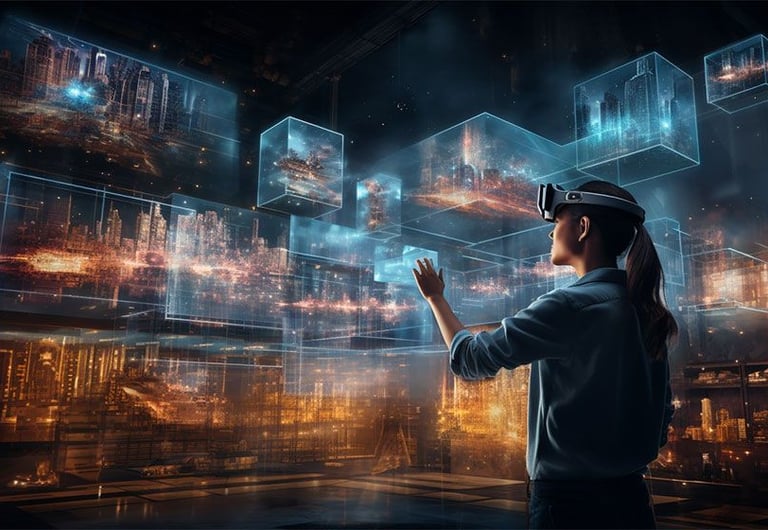Spatial Computing and Marketing: Designing for the 3D Web
As we move into the era of the 3D web, spatial computing is transforming how users interact with digital content. This blog dives into how spatial UI/UX design is influencing content marketing, product visualization, and user engagement in AR, VR, and XR environments.
7/20/20255 min read


In the context of marketing, spatial computing has emerged as a groundbreaking tool that enhances consumer engagement through interactive and immersive experiences. For instance, AR applications allow users to visualize products in their own environment before making a purchase. Furniture retailers, such as IKEA, have successfully employed AR technologies to enable customers to place virtual furniture in their homes, helping them to make informed decisions. VR, on the other hand, offers fully immersive experiences that transport users to different worlds. Brands like Volvo have utilized VR test drives, allowing potential buyers to explore and experience vehicles in a virtual setting.
The significance of spatial computing in current marketing strategies cannot be overstated. As consumers increasingly seek more engaging and personalized experiences, brands are recognizing the need to adopt these advanced technologies to meet evolving expectations. The rise of MR further enhances this interplay between reality and digitality, enabling seamless interactions with both real objects and virtual elements.
Current industry trends indicate a growing investment in spatial computing across various sectors. Companies across retail, entertainment, and education are actively exploring XR solutions to enhance customer interaction. As technology advances and becomes more accessible, the potential applications for spatial computing will undoubtedly expand, offering new avenues for marketers to connect with their audiences in innovative ways.
The Role of Spatial UI/UX in Marketing
In the rapidly evolving landscape of spatial computing, the significance of user interface (UI) and user experience (UX) design becomes increasingly paramount. As marketing strategies transition towards the 3D web, traditional design principles must be adapted to meet the unique challenges and opportunities presented by spatial user interfaces. This transformation necessitates an understanding of how consumers interact with immersive environments and the essential elements that govern their experiences.
Spatial UI/UX design is not merely an extension of two-dimensional design; it requires a rethinking of user interactions within three-dimensional spaces. For marketers, this implies creating interfaces that are not only visually appealing but also intuitive and easily navigable. Engaging the user necessitates a user-centered approach where every element of the design is crafted with the end-user's experience in mind. This includes considering factors such as spatial orientation, gesture-based navigation, and the overall sensory experience. The challenge lies in ensuring that users can effortlessly engage with content without feeling overwhelmed or disoriented in a virtual environment.
Best practices for effective spatial marketing include simplifying navigation and minimizing cognitive load, employing consistent visual language, and utilizing familiar interaction paradigms. Case studies demonstrate the impact of well-executed spatial UI/UX design; for instance, campaigns that leverage augmented reality (AR) have shown significant increases in user engagement and brand recall. Brands like IKEA have effectively used spatial computing to allow customers to visualize products in their homes before making a purchase, offering an intuitive and interactive shopping experience.
Moreover, as the realm of spatial computing expands, the integration of artificial intelligence can further enhance the personalization of marketing messages and product displays. Understanding users' preferences through data analytics will enable brands to create tailored experiences that resonate on a deeper level. In this new era of spatial UI/UX design, marketers are challenged to innovate continually, ensuring that they capture the attention of users in a dynamic and interactive environment.
Enhancing Product Display Through Spatial Marketing
The advent of spatial computing has significantly transformed the landscape of marketing by allowing businesses to create immersive product displays and merchandising strategies. Unlike traditional methods of product presentation, spatial marketing employs the power of 3D environments to engage potential customers in a more dynamic manner. When brands utilize extended reality (XR) environments, they unlock new avenues for customer interaction that were previously unattainable, thus reshaping buyer behavior.
One prime example of effective spatial marketing is IKEA's application of augmented reality (AR) in its mobile app. By allowing users to visualize furniture in their own homes through 3D renderings, IKEA not only enhances the product display but also enables customers to make informed purchasing decisions. This interactive experience ultimately contributes to a higher degree of customer satisfaction and engagement, as buyers can visualize the size, color, and style of furniture items in real-time.
Furthermore, the implementation of 3D product visualizations enables brands to showcase intricate details and features that are often overlooked in conventional two-dimensional formats. For instance, brands in the fashion industry can utilize 3D models to present clothing items from various angles, allowing customers to see how garments move and fit. This level of detail fosters a deeper connection to the product, enhancing the overall shopping experience and driving conversion rates.
Additionally, spatial marketing strategies can significantly impact customer retention. By creating memorable experiences through interactive showcases, brands forge stronger emotional ties with their audience, encouraging repeat purchases. As customers become accustomed to richer product displays, their expectations evolve, emphasizing the importance of adopting immersive technologies for effective product presentation.
In essence, spatial marketing stands to redefine how products are displayed and experienced, compelling businesses to embrace innovative solutions to enhance customer engagement and influence purchasing decisions.
Future Trends in Spatial Marketing and Content Creation
The days of flat, two-dimensional experiences are swiftly becoming a relic of the past, as advancements in spatial computing continue to shape the marketing landscape. As organizations turn to immersive technologies—such as virtual reality (VR), augmented reality (AR), and mixed reality (MR)—the significance of these tools in marketing strategies becomes increasingly evident. One of the most prominent trends in spatial marketing is the integration of artificial intelligence (AI). By utilizing AI-driven analytics and content creation, marketers can deliver hyper-personalized experiences that not only engage customers effectively but also anticipate their needs and preferences.
A critical area of innovation is the evolution of extended reality (XR) hardware. As devices become more accessible and sophisticated, marketers will be able to leverage an array of interactive touchpoints. This hardware evolution will allow brands to craft highly impactful multi-sensory experiences that resonate with consumers on a deeper level. As reality blurs between the physical and digital worlds, brands will have enhanced opportunities for storytelling and immersion, thereby redefining customer interactions. Furthermore, advancements in 3D content creation tools will democratize access to immersive environments, empowering even small businesses to produce high-quality spatial experiences without the need for extensive technical expertise.
Looking to the future, brands should remain adaptable, embracing innovation within the spatial marketing landscape. Anticipating shifts in consumer expectations will be crucial, as customers increasingly demand seamless experiences that reflect their interests while integrating with their everyday lives. Collaboration between marketing teams, designers, and technology developers is essential to keeping pace with these transformations. As immersive technology continues to evolve, brands equipped with cutting-edge tools and strategies will stand out in creating lasting connections with their audiences. Harnessing the full potential of spatial marketing will not only enhance brand visibility but also ensure relevance in this ever-changing digital sphere.
Understanding Spatial Computing and XR Environments
Spatial computing refers to the integration of digital and physical environments, where users interact with computer-generated content in a three-dimensional space. This innovative approach is gaining significant traction within extended reality (XR) environments, encompassing augmented reality (AR), virtual reality (VR), and mixed reality (MR). Each of these immersive technologies presents unique user experiences by blending digital elements with the real world or creating entirely virtual surroundings.
Expert digital marketing solutions for your business.
Reach Out To Us
📞+91-7060648052
📞+91-8410130096
© 2024. All rights reserved.
Quick Links
Find Us On Social Media


Get To Know More About Us
